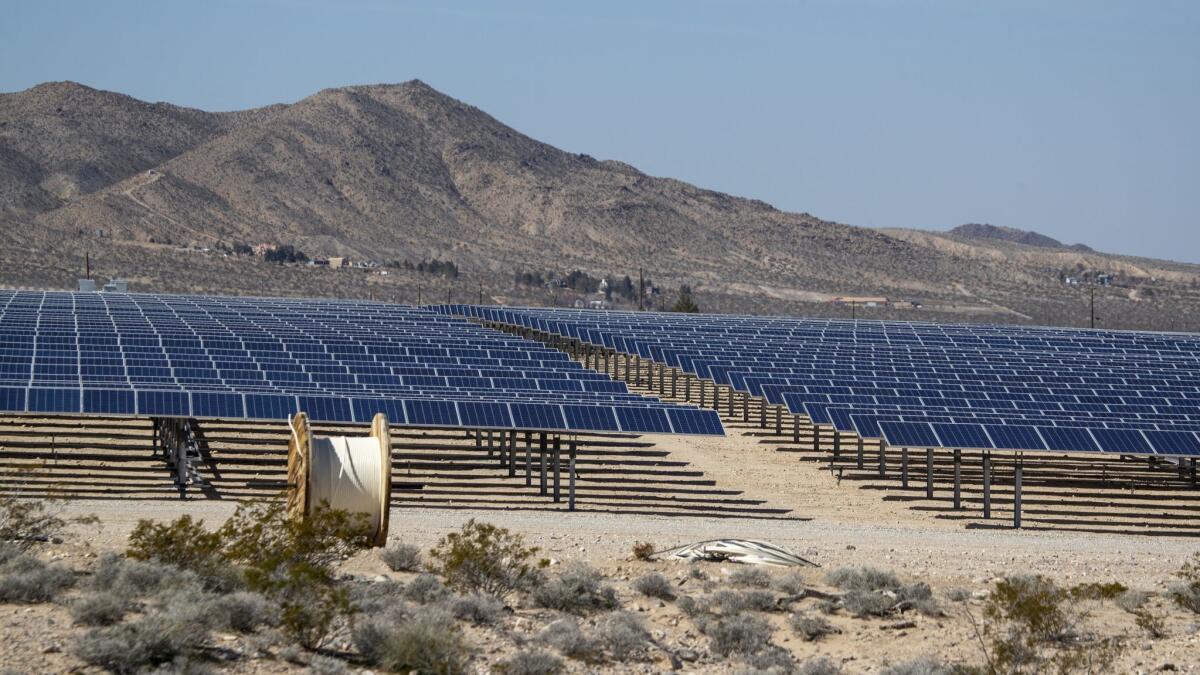Editorial: Green power runs up against desert conservation in California

- Share via
California lawmakers’ grand ambitions to fight climate change are running into a familiar obstacle: the parochial concerns of local governments and property owners.
The latest battle over state needs vs. local control is being fought in San Bernardino County, where the Board of Supervisors voted last month to ban solar and wind farms across vast stretches of rural desert communities. The decision was cheered by residents who have complained that the proliferation of large renewable energy projects threatened to wipe out their scenic vistas and upend the fragile desert ecosystem.
San Bernardino County’s ban comes just as California is supposed to be dramatically ramping up its renewable energy usage as part of the state’s effort to slash the carbon emissions that promote climate change. Last year, Gov. Jerry Brown signed a bill requiring utility companies to get 60% of their electricity from renewable sources by 2030, and 100% from zero-carbon sources by 2045. And demand for power is only going to grow as California shifts the transportation sector from fuel pumps to the electric grid through battery-powered cars, buses and trucks.
It would be too simplistic to dismiss all of San Bernardino County’s concerns as just the typical NIMBY response.
Weaning the state completely off electricity produced from fossil fuels will require a significant expansion of green power sources, such as wind turbines and solar panels, as well as the development of batteries to store power when the wind isn’t blowing and the sun isn’t shining. Utilities are banking on more large-scale solar and wind farms which, because of their economies of scale, can produce electricity as cheaply as fossil-fuel-powered plants. But those projects become more difficult to build as rural communities restrict land.
San Bernardino County isn’t alone. Los Angeles County bans large-scale wind farms in its unincorporated areas. San Diego, Inyo and Solano counties have put restrictions on large-scale wind installations. The Obama-era Desert Renewable Energy Conservation Plan enacted in 2016 set aside only 388,000 acres — roughly 4% of 10.8 million acres of federal land — for commercial-scale renewable energy projects.
The Times Editorial Board supported the desert plan as a good compromise that balanced the demand for green energy projects with the need to preserve public land and the desert ecosystem. Yet there’s no ignoring the fact that as more and more land is taken off the table for renewable energy development, the green power projects California needs to reduce fossil fuel consumption become harder to build.
Enter the Fray: First takes on the news of the minute »
Some of the opposition in San Bernardino County is driven by residents who simply don’t like the idea of solar panels or wind turbines marring their pristine views. But it would be too simplistic to dismiss all of San Bernardino County’s concerns as just the typical NIMBY response. The resistance also stems from a real debate among climate activists in California about how the state should meet its ambitious renewable energy goals.
On one side are those who advocate decentralizing energy generation by developing smaller installations, such as solar panels on rooftops and parking lots, that can keep delivering local power if a fire or other disaster knocks out transmission lines. On the other are those who want to develop more industrial-scale projects that can generate lots of cheap green power, along with transmission lines to deliver the electricity wherever it’s needed.
They are both right. The state needs an “all of the above” approach to renewable energy. The pushback in San Bernardino and other rural counties ought to prompt the state and utilities to do much more to support the installation of solar panels and small-scale green power investments in urban areas. But local governments also can’t close off vast swaths of land to green power — not if California is going to reach 100% renewables and decarbonize the economy fast enough to prevent the most devastating effects of climate change.
Follow the Opinion section on Twitter @latimesopinion and Facebook
More to Read
A cure for the common opinion
Get thought-provoking perspectives with our weekly newsletter.
You may occasionally receive promotional content from the Los Angeles Times.










